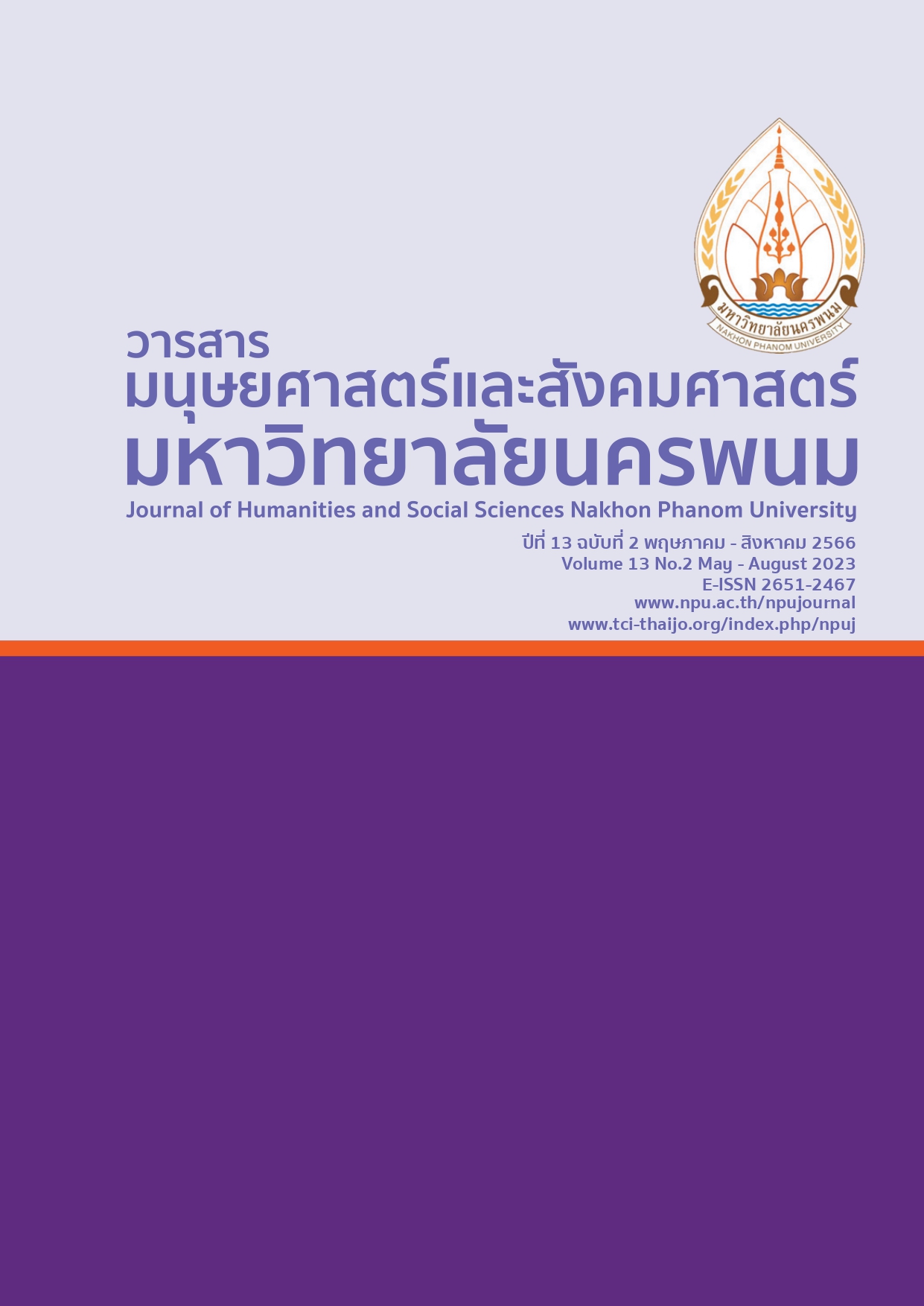The Process of Creating a Geography Learning Community: A Case Study of Ban Dong Tong Moo 6, Pha Tang Sub-district, Sangkhom District, Nong Khai Province
Main Article Content
Abstract
This research aimed to establish a geography learning community at Ban Dong Tong Community, Moo 6, Pha Tang Sub-district, Sangkhom District, Nong Khai Province. The target group was selected purposively amount to 66 people, which were divided into 26 university students, 30 students, and 10 community representatives. This research used SECI Model integrated with a participatory action research process and a learning process in geography. The results showed that all of 3-target groups participated in creating a geography learning community in Ban Dong Tong community as the study area. The group of university students conveyed their knowledge of geography, the group of students provided community’s information, and the group of community representatives provided the additional information and verified the accuracy of the data until there was the process of learning management in geography using geography tools and geoinformatics to learn from the database from learning in the community such as satellite map outlines, geo-social mapping, and geocoding device. A group of the students and the university students collaboratively created a geo-social mapping using a simple survey process and was checked and edited by the community representatives, which this process presented the acquisition of knowledge and skills in geography for this learning community according to the objective of this learning community that led to the creating the geo-social mapping with the geo-informatics system software in order to be able to examine the accuracy of the acquired data. Finally, there was a presentation of the results to the community in order to identify the lessons learned and plan for developing the community in any other aspects in the future.
Article Details

This work is licensed under a Creative Commons Attribution-NonCommercial-NoDerivatives 4.0 International License.
References
Anantasuk, N., Kaewurai, W., Onthanee, A. and Jantakoon, J. (2021). Manō that wādūai kānsō̜n phūmisāt nǣo mai phư̄a kān rūrư̄ang phūmisāt khō̜ng nakrīan radap kānsưksā naphư̄n thān [A Concept of New Geography Instruction for Geo-Literacy of Students in Basic Education]. Journal of Education Mahasarakham University. 15(2),7-21.
Department of Environmental Quality Promotion. (2014). Khūmư̄ kānrīanrū læ samrūat chumchon [Community survey and learning handbook]. Bangkok : Environmental Education Section, Public Education and Extension Division, Department of Environmental Quality Promotion Ministry of Natural Resources and Environment.
Department of Mineral Resources. (2009). Kān čhamnǣk khēt phư̄a kānčhatkān dān thō̜ranīwitthayā læsapphayākō̜nthō̜ranī čhangwat Nō̜ng KhāI [The Classification of Nong Khai Province Area forGeology and Mineral Resources Management]. Bangkok : Department of Mineral ResourcesMinistry of Natural Resources and Environment.
Jeena, K. and Khutrakun, A. (2018). Krabūankān thāithō̜t khwāmrū čhāk mahāwitthayālai sū chumchon : kō̜ranī sưksā khrōngkān ʻanurak wihān phračhao phan ʻong wat pong sanuk čhangwat Lampāng [Knowledge Transfer Process from University to Community: A Case Study of Viharn Phra Chao Pun Ong Conservation Project, Wat Pong Sanuk, Lampang Province]. Journal of Political Science and Public Administration Chiang Mai University. 9(1),59-80.
Khongsanthia, C., Jantharasa, R., Rungwannasak, K., Mekara, N. and Thuaisom, C. (2023). Kānčhatkān ʻongkhwāmrū phư̄a kān phœ̄iphrǣ phūmpanyā thō̜ngthin ʻĪsān : kān pradit phūangmahōt (phūang mālai ʻĪsān) [The Knowledge Management for Dissemination of I-San Local Wisdom:Invention of Phuang Ma-Hotra Paper Craft (I-San Garland)]. Arts and Culture Journal of the Lower Moon River Surin Rajabhat University. 12(1),1-15. doi : http://dx.doi.org/10.14456/acj.2023.1
Nonaka, I. and Takeuchi, H. (1995). The knowledge creating company: how Japanese companies create the dynamics of innovation. New York : Oxford University Press. doi http://dx.doi.org/10.1016/0024-6301(96)81509-3
Pengmol, T., Kanlaya, S. and Wita, N. (2018). Kānčhatkān ʻongkhwāmrū thāng watthanatham phư̄a kānthō̜ngthīeo yāng yangyư̄n [Cultural Knowledge Management for Sustainable Tourism]. Journal of Local Governance and Innovation Surin Rajabhat University. 2(3),93-106.
Phakdeetham-Chimvilaisup, A. (2019). Kānphatthanā chumchon yāng yangyư̄n : kō̜ranī sưksā chumchon bān mǣ sapō̜k tambon mǣ Win ʻamphœ̄ Mǣ Wāng čhangwat Chīang Mai [A Sustainable Development of Thai Community: A Case Study of Ban Mae Sa Pok Community, Mae Wang District, Chiang Mai Province]. In Kanda Wongwailikit (Ed.), Big Data and New Face of Asia : Reflection in Science, Arts, Social Sciences, and Humanities. RSU National Research Conference (500-509). Rangsit University.
Phetnawa, W. and Sukjairungwattana, T. (2020). Nǣothāng kānphatthanā chumchon hǣng kānrīanrū thāng wichāchīp khō̜ng rōngrīan matthayommasưksā nai saha witthayākhēt Wiphā Wadī Krung Thēp Mahā Nakhō̜n [Guidelines for Developing a Professional Learning Community in Secondary Schools in the Vibhavadi Academic Group, Bangkok]. Journal of MCU Social Development. 6(2),93-107.
Rattanarungsri, T. (2019). Kānphatthanā rūpbǣp kānsāng chumchon kānrīanrū thāng wichāchīp phư̄a sœ̄msāng khwāmsāmāt nai kānčhatkān rīanrū khō̜ng khrū phāsā Thai nai kānphatthanā thaksa kānsư̄sān yāng sāngsan khō̜ng nakrīan chan matthayommasưksā [The Development of the Construction Model of Professional Learning Community to Enhance Thai-Language Teachers’ Learning Management Capability to Develop the Creative Communication Skills of High School Students]. Phuket Rajabhat University Academic Journal. 15(1), 103-127.
Sangkom Subdistrict municipality. (2022). Khō̜mūn thūapai [Basic information]. Retrieved May 2022, from https://www.sangkhom.go.th/index.php?show=menu&file=detail&id=13.
Suppawimut, W. (2022). Khwāmrū kīeokap khrư̄angmư̄ thāng phūmisāt [Geographical tools]. Retrieved May 2022, from https://geo.cmru.ac.th/?p=1511
Whyte, W. F. (1991). Participatory Action Research. London : Sage Publications Inc. doi : http://dx.doi.org/10. 4135/9781412985383


